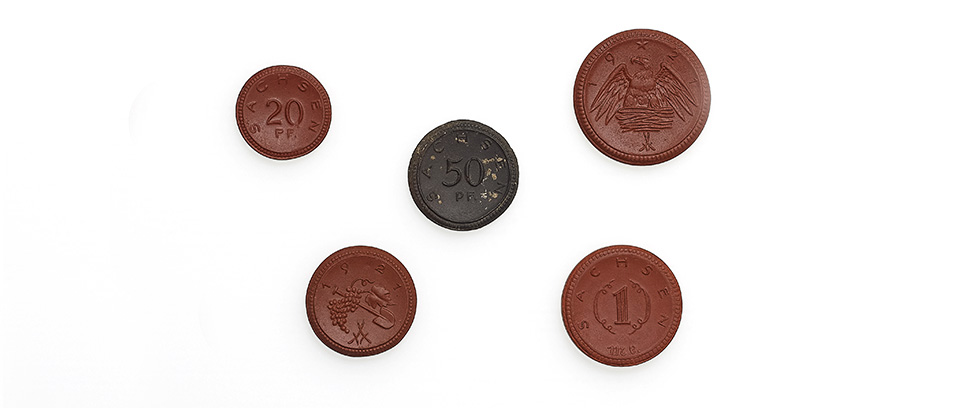
Making money out of natural materials – Porcelain emergency money
Lili Reyels | 13 March 2024
A glance at the collections of the Deutsches Historisches Museum reveals the immense variety of objects that are related to different epochs and topics of German history. They tell stories of our past or current lives, of famous or often unknown persons and events. In our new blog series #Umweltsammeln (#Environmentcollecting) we present various objects that have to do with the topic of “environment”. Unexpected questions raised by the heads of the different collection sections open new perspectives on historical objects and often reveal startling parallels to questions that deal with our current world.
At times of crisis, natural materials such as clay were used not only in the usual way, such as to make vessels, but they also found imaginative new uses. Examples of this repurposing can be found in the museum’s Financial and Economic History collection, as Dr Lili Reyels, head of the collection, reports.
After the outbreak of the First World War, cash became scarce because the people hoarded the coins, which contained precious metals. Due to rising inflation, money had lost its value, and soon the silver in a one mark coin was worth more than the mark itself. For this reason the Reichsbank brought so-called “Darlehnskassenscheine” (loan society banknotes) as well as coins made of zinc and iron into circulation, but the Germans still had a shortage of coins. It even became difficult to pay wages. At the end of 1916, the Reich Minister of Finance finally allowed communities and large companies to produce their own local means of payment. Towards the end of the war, the need for small change again grew by leaps and bounds. Metals such as copper and nickel were needed for the arms industry. Thus arose the idea of making “Notgeld” – emergency money that substituted for the former “real money” – not only out of paper, but also using the natural material clay.
From a historical point of view, this idea goes back above all to the numerous medals and medallions made out of porcelain, which were based on the original metal medals, whose forms were similar to coins. This idea was first realised in 1917, when the first ceramic emergency coin – a 10 pfennig piece – was produced by the Philipp Rosenthal & Co. porcelain factory in Selb (North Bavaria).
This was followed by other companies, including the Pfeffer porcelain factory in Gotha, which produced the city’s emergency money made of so-called “Pfeffer porcelain”. As it turned out, the material and minting technique were not adequate and the production was finally abandoned. In 1921 the city of Gotha had new coins minted by the Meissen State Porcelain Manufactory. The Deutsches Historisches Museum has a so-called “Quartz Coin” from Gotha with a value of 50 pfennigs in its collection.
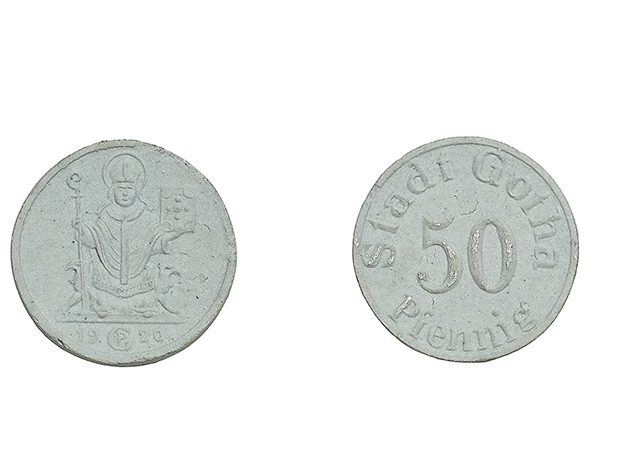
Thereafter, the various emergency coins from Meissen made of porcelain stoneware and bisque porcelain gained considerable fame. Emergency coins made of “Böttger stoneware” were minted in Saxony for many different German cities and communities. Friedrich Wilhelm Hörnlein, a coin engraver and medallist at the Saxon State Mint in Muldenhütten, cut the steel stamps used to produce the coins, based above all on designs by Emil Paul Börner, a sculptor and artist from Meissen.
Stoneware is a kiln-fired ceramic mass. In order for the shards to achieve stoneware quality, the ceramic mass normally has to be fired at temperatures between 1,200°C and 1,300°C. Saxony in particular preserved the tradition of porcelain and stoneware manufacture and drew from this tradition, as it were, to produce Notgeld. “Böttger stoneware” had been developed in 1706 by Johann Friedrich Böttger, an apothecary and early alchemist, and Ehrenfried Walther von Tschirnhaus, a natural scientist and head of the Saxon Electoral Laboratories. Porcelain stoneware is a “red porcelain” – for a few years Böttger stoneware was produced for the Saxon electoral court using a mixture of raw materials from the environs of Dresden, including clay, red bolus and iron oxide. Augustus II the Strong, Elector of Saxony, issued a decree determining that such porcelain had to contain only domestic raw materials – an early example of sustainability and regionality.
According to a decree of the Saxon Finance Ministry, porcelain Notgeld manufactured in Meissen in the early 20th century had to be made of the same original combination of materials as in the early 18th century. The material offered many advantages for its circulation as currency: it was impervious to water, did not get dirty easily, and was highly resistant to breakage. Due to the slight, key-like indentation in the middle of the coins, the main part of the mass was found on the edge, which stabilised it. Coins of the same value could be stacked and wrapped in rolls for transport.
The Meissen State Porcelain Manufactory in Saxony had begun in 1919 to design test models of the coins, to mint them and fire them in separate kilns. The director of the manufactory, Max Adolf Pfeiffer, had large-scale plans, because the Finance Ministry of the German Reich had considered issuing official ceramic emergency money on a national basis. An intense discussion broke out about the advantages and disadvantages of ceramic money made of red porcelain stoneware, but in the end it was decided not to issue ceramic money officially throughout the Reich. The test models of the coins from 1920 therefore were primarily of value to collector – soon after the coins appeared they were highly sought after in the relevant circles.
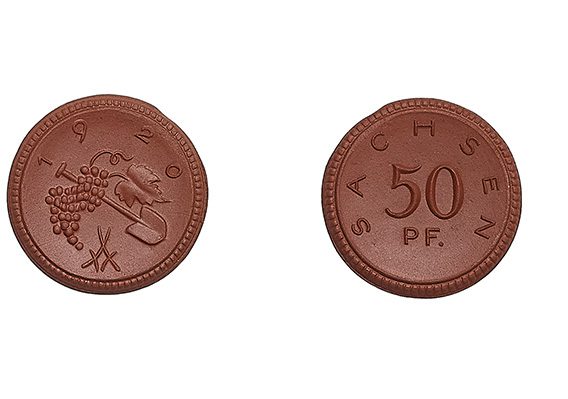
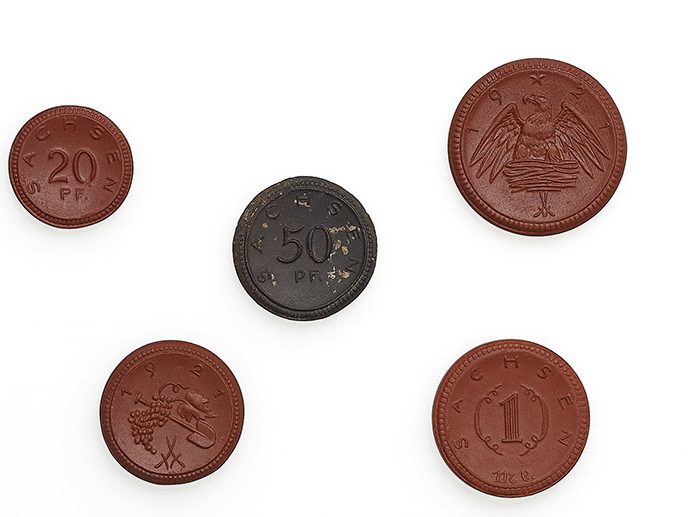
Coins valued at five, ten and 20 Marks were made. The Meissen manufactory produced the Notgeld directly on behalf of the Saxon state, but was not considered the official mint of Saxony. In the end, only coins minted with the permission of Berlin in 1921 and bearing that date were allowed to be used as Notgeld.
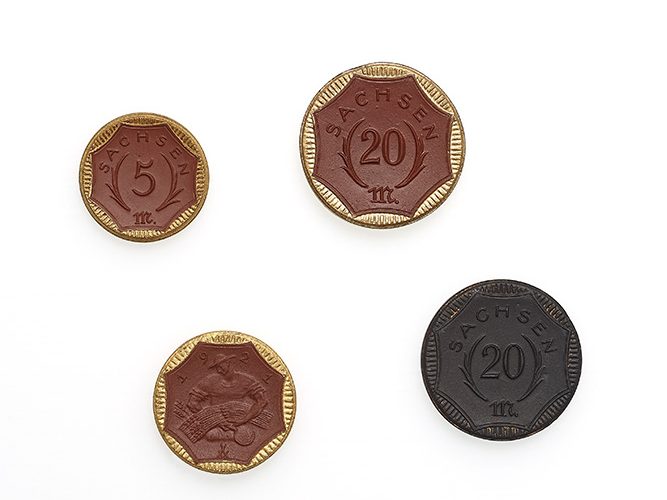
The gold decoration on the five, ten and 20 Mark coins was designed to recall the earlier gold currency of the Reich; these denominations had been in circulation as gold pieces before the First World War. After the colours had been painted on, the coins were fired again. In addition to the obligatory information about value, date and origin with typical motifs from the different branches of production, a sword sign on every coin indicated its original source from the Meissen Porcelain Manufactory.
The Meissen porcelain money even attracted international interest. When Guatemala in Central America contemplated issuing new coins, they commissioned samples of 2-peso pieces in 1922, which were designed by Emil Paul Börner. In the end the coins were not issued.
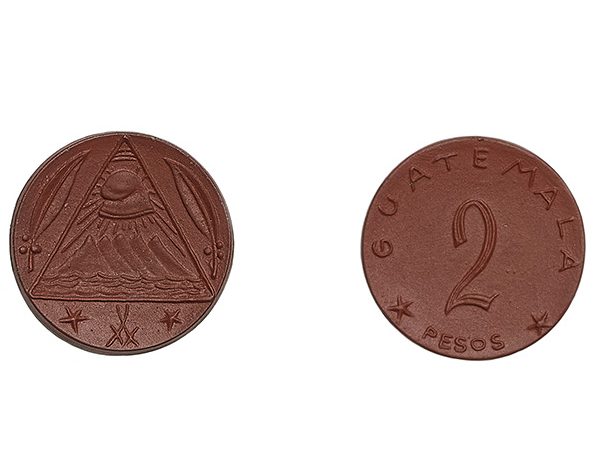
On 17 July 1922, all production of emergency money was forbidden, a decree that was not always obeyed, however. The value notations were simply replaced by other symbols, such as an oak leaf or a rosette.
On 1 November 1923, the so-called “Rentenmark” was introduced. Soon after, the porcelain Notgeld coins disappeared.
Literature
Scheuch, Karl: Münzen aus Porzellan und Ton der Staatlichen Porzellan-Manufaktur Meissen und anderen Keramischen Fabriken des In- und Auslandes, Biebertal 1978, p. 35
Münzen aus Porzellan, in: Das Fenster in der Halle der Kreissparkasse Köln, März 1962
|
|
Dr. Lili ReyelsDr. Lili Reyels is the head of the Financial and Economic History Collection at the Deutsches Historisches Museum. |
